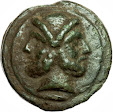Anonymous Æ
Aes Grave Triens
Thunderbolt / Dolphin – Cr 14/3
289 - 245 BC
Anonymous Æ
Aes Grave Triens (= 4/12 or 1/3 of an As); the coin was cast in Rome (according to
Crawford, Thurlow & Vecchi and Rutter) or Campania (according to Sydenham),
the period of minting ranges from circa 289 BC for heavier coins to about 245
BC for lighter coins. The obverse has a thunderbolt and four pellets. The
reverse has a Dolphin swimming right and below are four pellets. T&V comment
that the thunderbolt is an attribute of Jupiter, the chief god of the Romans
and the dolphin is an attribute of Neptune. The coin weighs 94.91 grams and has
a diameter of 49 mm. A small piece of the coin is missing. The reverse is at
10:00 relative to the obverse. The coin was graded VF with a light brownish ‘Tiber’
patina and came from a private German collection. Attributions for the coin:
·
Crawford, Roman Republican Coinage - 14/3 –
Crawford gives the 14 series As a weight standard of 322 grams for this series.
Three times 95 = 285, which is a bit below the weight standard, but well above
the 267 gram average for the 85 examples of Cr 35/1 I found.
·
Thurlow & Vecchi, Italian Cast Coinage – 3a
- The weight of the coin places it in the later period by T&V and thus the “a”.
·
The coin is not in Grueber, Coins of the Roman
Republic in the British Museum. It is listed in BMC Italy and is on the British
Museum web site.
·
Sydenham, Aes Grave – 38; Coinage of the Roman Republic
– 10
·
Sear – 538
·
Rutter, HN Italy 270
·
ICC 27
·
Haeberlin pp. 95-97, 1-160 pl. 39, 6-14
| Country | Roman | |||
| Type or era | Roman Republican | |||
| Coin type | AES Grave Triens | |||
| Mint | Rome | |||
| Issued by | Anon Cr 14.3 | |||
| Issued by | anonymous | |||
| Title of issuer | ||||
| Mint Date, BC | -289 | -289 to -245 | ||
| Weight, grams | 94.90 | this coin | ||
| Weight - max | 124.82 | |||
| Weight - min | 71.36 | |||
| Weight - avg | 98.270 | |||
| Weight - st dev | 11.784 | |||
| Number | 45 examples found | |||
| Diameter - max | 49 | this coin | ||
| Diameter - min | to be measured | |||
| Diameter - max | 52.0 | |||
| Diameter - min | 43.0 | |||
| Diameter - avg | 47.818 | |||
| Diameter - st dev | 2.500 | |||
| Metal | AE | |||
| Serrated | N | |||
| Cr | 14/3 | |||
| BMCRR | ||||
| Sear: #, VF, EF | 538 | |||
| RSC: #, VF, EF | ||||
| CRR / AG | 10 | 38 | ||
| CRI | ||||
| NMWar | ||||
| NMCr | ||||
| Orientation | 10 | |||
| Orientation | ||||
| Purchased from |
|
|||
| Purchase date | 12/28/2013 | |||
| Price | ||||
| Currency | Pound | |||
| Excahange rate | 1.65 | |||
| Grade | ||||
| Grade | VF | |||
| Centering | well centered | |||
| Strike | cast, some surface irregularities as expected for cast coin, objects not well formed | |||
| Flan flaws | ||||
| Style | not the sharpest example I found, but features can be seen | |||
| Patination | light brown, "Tiber" patina | |||
| Damage | small piece missing, adjustment to weight? | |||
| Obverse | Thunderbolt | |||
| Reverse | Dolphin | |||
| Obverse | Thunderbolt, 4 dots | |||
| Reverse | Dolphon, 4 dots | |||
| Examples Haeberline | 160 | |||















